Text
Retour en mer

Ça y est, nous sommes est à bord de notre nouvelle maison!
Le bateau est chargé, les cales remplies, les pleins faits: on est fin prêts pour faire la traversée pour la Corse ! On est en pleine zone Pelagos, une aire de protection de cétacés entre la côte française, italienne et corse. Pendant les quarts de la traversée, on a la chance d’apercevoir deux paires de rorquals communs, plusieurs dauphins stenella, des tortues et des poissons lunes ! La mer est d’huile, et on peut bricoler sur le pont du bateau un nouveau système qui va nous éviter de pomper 45 min toutes les 6h pour les jarres. On arrive à Saint Florent, première escale corse!



Les activités de sensibilisation reprennent, avec la rencontre d’une classe à St-Florent avec l’association Corse Mare Vivu, et d’un stand tenu à Calvi. Les prélèvements avec le filet Manta sont aussi de retour, car il faut rattraper le temps de pause dû à la recherche du bateau. Cette semaine, on a pu faire 3 prélèvements en triplicats pour le LNE et APT, et 4 points pour OceanEye avec le filet de la SCS ! On a pris nos repères sur le Five, et nous sommes de plus en plus efficaces.
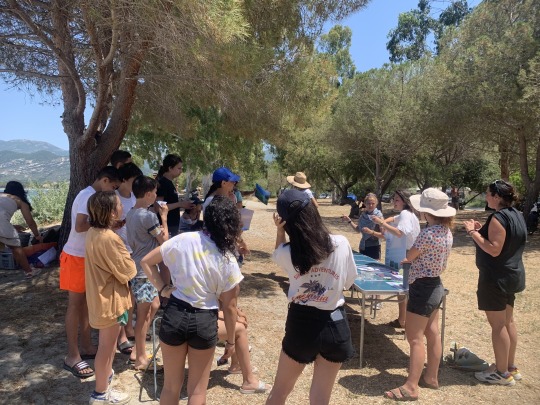


0 notes
Text
Seaplastics en Méditerranée
Bonjour à tous et toutes !
Je m’appelle Laurine et je suis étudiante en master SV à l’EPFL. J’ai fait mon Bachelor dans cette même section et j’ai pu partir en 3ème année à NTNU Trondheim en Norvège. Là-bas, j’ai pu découvrir la biologie environnementale et plus largement les sciences de l’environnement. L’implication concrète des études dans nos problématiques de climat actuelles m’a beaucoup plu, avec l’impression d’avoir un pied dans le réel et d’essayer, humblement, de comprendre et de faire bouger les choses. De retour à l’EPFL, j’ai gardé cette orientation par le choix de mes cours et des stages.

En mars 2021, j’ai pu rejoindre l’équipe SEA Plastics, avec Anne-Laure, Alice et Clara. Ce projet étudiant d’AgroParisTech a pour but chaque année de monter une expédition de 4 mois en mer Méditerranée.
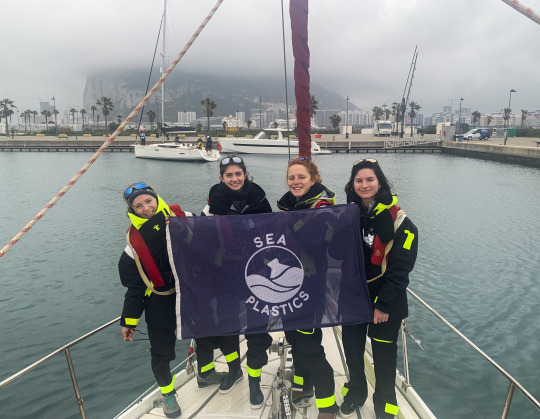
A bord du voilier-laboratoire, nous effectuons des prélèvements pour le LNE (Laboratoire National de Métrologie et d’Essai) et AgroParisTech dans le cadre d’une étude sur les méthodes de caractérisation des microplastiques. Ce partenariat est dans la continuité du travail de l’équipe SEA Plastics de l’année passée, et les nouveaux échantillons permettent d’améliorer les protocoles et d’avoir des données comparatives.
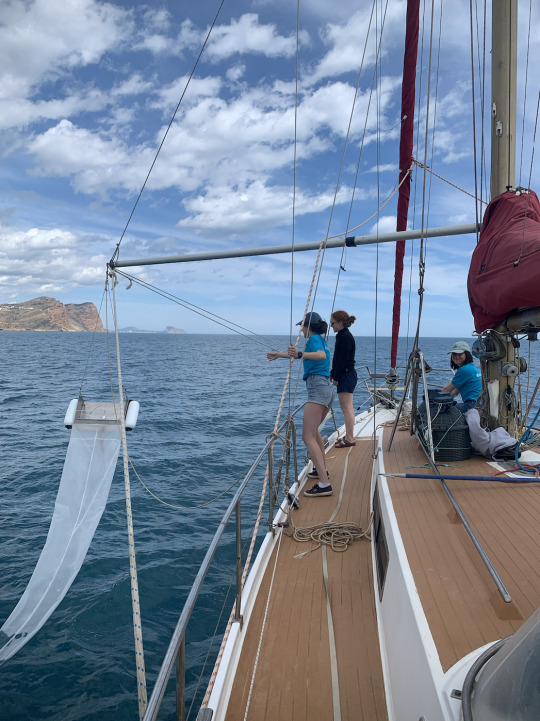
Nous participons également à la mise en place de la base de données international de OceanEYE (Genève), qui est partagée avec le Programme des Nations Unies pour l’environnement. Cette année, nous avons aussi monté nos propres expériences sur le bateau, pour étudier les cinétiques d’adsorption des micropolluants sur les microplastiques, et le vieillissement des plastiques en conditions marines. Épaulées par Mr. Breider dans le design des expériences, nous avons également été aidées par de nombreuses personnes de l’EPFL dans la conception. Nous avons découvert le défi que représentent les expériences embarquées et les mesures du terrain… ! Le système que nous avons finalement mis à bord à Gibraltar le 29 mars est le résultat de l’imagination, débrouillardise, motivation, solidarité et discussion de nombreuses personnes. Encore merci à elles et eux !
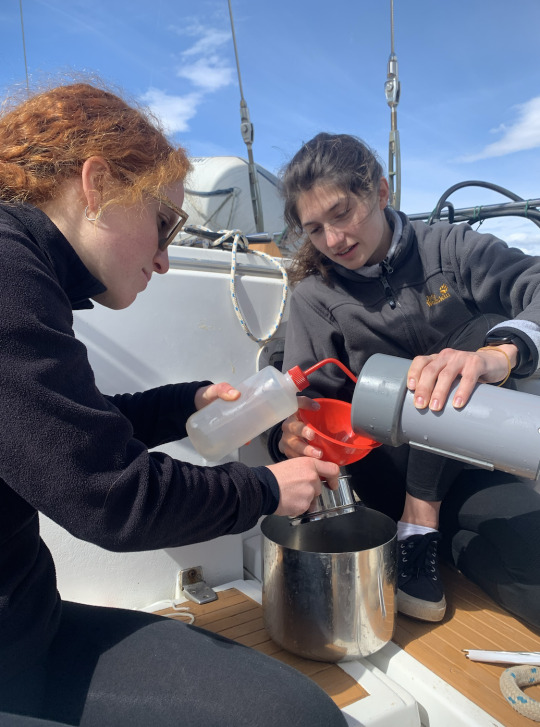
L’expédition est aussi rythmée par les escales dans les ports. On y retrouve des classes pour des ateliers, on monte des stands. Parler de cette pollution au plus grand nombre de personnes est notre deuxième défi ! Jeu, conférences, news lettre pédagogiques et réseaux sociaux, on essaie de diversifier les points d’accroche. L’expédition est sportive, humainement intense et scientifiquement très enrichissante ! Tout est source d’apprentissage! 😊

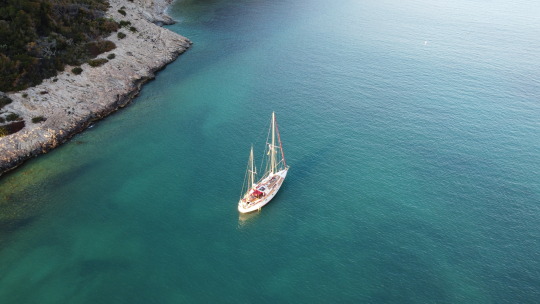
0 notes
Text
The Rainless Transect
Patagonia. An austral territory partitioned between Chile and Argentina, famous for its wild landscapes and unparalleled beauty, hosts the largest ice masses outside Antarctica and Greenland. Notorious for its intense rainfall and ferocious winds, it was selected as the starting point of the 11th Vanishing Glaciers expedition. In theory, this wild setting would tune our team with the boreal winter conditions we left behind by mid-January. So it made more sense that in our quest to be in “Harmony with Nature” to start in the most wintrery part of Chile to avoid potential climatic shocks.
Again, things worked again in the opposite direction to our desires. To our “disappointment” right from the first day we were confronted to the heat and the blazing austral sun, totally disharmonized from the boreal winter and the harsh weather continuum built over the last year’s expeditions in the Himalayas, Pamirs and in Uganda’s Rwenzori Mountains. By the time of our arrival, Patagonia was experiencing a heat wave. But this time, the climatic paradoxal conditions were greeted as a good surprise, with a “too good to be true” feeling suspended in the air that stayed with us for the entire expedition.

The first sight of the Patagonian glaciers was something like “love at first sting”. Vulcan Michinmahuida seen from the ferryboat ride from Puerto Montt to Chaiten (Photo © Mike Styllas)
Going the distance full house
Our plan involved the sampling of glacier streams and rivers spanning the diverse climatic regions of the wet and dry Andes. Two years ago, we worked in the tropical Andes of Ecuador, so in order to get a representative view of the entire Andes mountain chain we planned to work along a 1500km traverse from northern Patagonia, to Val de Maipo, northwest of the capital Santiago.
In this trip, we were not just usual four suspects, but the house was full. Our colleague Peter Hannes joined us for the first part of the expedition. Hannes who was the locomotive of the inaugural Vanishing Glaciers expedition in New Zealand, resolving ever surfacing fieldwork setbacks when the rest of us were struggling to figure out the sampling protocols and make proper use of the equipment, had also surprised us with his fly fishing capacities. Same story, different place. In Patagonia, Hannes reminded the team that some delicate skills acquired in the field are there to stay and fresh trout became synonymous with his participation in the project’s expeditions. Luis Gomez, who was a member of the River Ecology lab for two years, also joined our ambitious fieldwork traverse from his new position, as a researcher in the Centre for Research on Ecology and Forestry Applications (CREAF), in Spain. As a native Spanish speaker, Lluis was there to help the team navigate through several delicate situations that would have taken us considerably more time and effort to resolve. Throughout our traverse, we also had several local colleagues from the Universidad Austral de Chile in Valdivia and the Universidad de Conception that contributed to the success of our back-to-back fieldwork campaigns and added a different flavor to our daily working routine, enriching our knowledge with social and political feats that shaped the modern history of Chile.

Guest stars Lluis (left) and Hannes (right) showing their special fieldwork skills…here pumping liters of very dirty (turbid) water in front of a Mocho outlet glacier (Photo © Matteo Tolosano)
A smooth and hot journey
One of the most frequent terms in nearly all previous updates is “logistical hurdles”. Herein, is omitted just because there was none. The pleasant weather in Santiago was complemented by a quick and easy experience with the Chilean customs, with the invaluable help of Professor Mauricio Gonzalez from INTA (Instituto de Nutrición y Tecnología de los Alimentos de la Universidad de Chile) and soon enough our equipment was travelling with us to the northern tip of Patagonia. Approaching the glaciers by the sea was a sort of deja-vu, as we had lived through a similar situation in our Greenland expedition, back in 2019. Sights of seals, green lush forests and low elevation rounded and heavily glaciated peaks under blue skies filled the cadre as the ferry was approaching the small town of Chaiten.

Living earth I. Pyroclastic flows on the moraine and volcanic ash covering Turbio glacier, with Vulcan Villarica steaming in the background (Photo © Martina Schoen)
Once we finished with the southernmost cluster of glaciers, we hit the road and moved northwards just to verify that Chile is a very active member of the Pacific “Ring of Fire”. The volcanoes of Villarica and Chillan were degassing constantly giving us the pace of earth’s breathing. Villarrica had a major eruption in March of 1971, when the upper part of the crater was cut by a 4 km long fracture and 30 million cubic meters of lava were ejected half kilometer above the crater and then flowed downslope as far as 14 km from the summit. The tephra fallout of this eruption covered an area of 200 km2 with black basaltic ash. Villarrica erupted for the last time on March 3, 2015, this time emitting gas, ash, and lava up to 1000m into the air. Even though we had worked in volcanoes before (Disko Island in Greenland, Mount Elbrus in Caucasus and in the Ecuadorian volcanoes), the sampling the glaciers of a steaming and vivid volcano was something new.

Living earth II. Volcano Chillan just breathed once more, alarming the evening calmness of our base camp (Photo © Vincent De Staercke)
Alive
“Welcome to my mountains” said Roberto Frank, as he was patiently waiting for our team to arrive in the gate and enter his property on our approach to Universidad Glacier. This glacier was an important feature of our long traverse, as it marks boundary between the wet and dry Andes, along which rock glaciers and other periglacial features do not exist further south. Aside from the scientific importance of the location, what we did not know is that Universidad glacier was the stage where one of the wildest acts of survival of the 20th century took place. Roberto described in detail the airplane crash above Universidad glacier in October 1972, when a military plane that was carrying the Uruguayan rugby team, crashed above our sampling point. The survivors of the crash, after resorting to cannibalism, had to find the strength to cross the glacier to make it down to the valley and call for help. The survival was brought to the broad public in 1974 through the book of Piers Paul Read “Alive”, which later on made it also to the big screen. To our luck, after the day we sampled Universidad Glacier, there was an event hosted in Roberto’s ranch where the helicopter rescue pilots and other people directly or indirectly involved in the accident were present along with the memories of this incredible story.

The intimidating mountaintops towering above Universidad glacier, a place where the ultimate act of surviving the Andes took place in 1972 (Photo © Mike Styllas)
The 150 milestone
Universidad glacier was not only a glaciological landmark, or a place of the ultimate survival act, but comprised the site where we celebrated the sampling of the 150th Vanishing Glaciers.

Juan, Mike, Gianni, Ramon, Matteo, Pablo. Luis and Martina with Vincent celebrating the 150th ice kiss. (Photo © Vincent De Staercke)
Past the 150-glacier milestone and upon our return from Chile, we figured out that so far we have ticked all but one points on the Vanishing Glaciers project destinations map. The final destination of our project’s expeditions is Alaska, and we are confident that after some time in the lab, our desire for more special encounters and fieldwork in the wilderness of The Last Frontier will revive more and more as the spring is coming in.
Our best wishes for a productive and pleasant springtime!
Martina, Matteo, Vincent and Mike
0 notes
Text
A High Prize for the Vanishing African Ice
The return of our team from the summery Uganda to the wintery Lausanne before the Christmas break had a feeling of achievement. Our tropical raid to sample the Vanishing African glaciers was awarded by a desired “window of opportunity” which gave the chance to collect our samples and run our experiments in a stunning setting that does not remind of Africa. However, the momentum was outpaced by the intense preparations for the following Andes expedition and the Festive Season, but on the other hand, this period gave enough time to recall the wonders of the Rwenzori expedition and organize a gesture of gratitude to the local people that made things work for us.

Martina Schoen and Matteo Tolosano enjoying the hidden frozen jewel of African nature, the Stanley glacier, in the only sunny day of a 2-week trekking raid in the Rwenzori Mountains (Photo © Mike Styllas)
For most people, glaciers in Africa are an obscured concept, shared between relatively few passionate mountaineers, who are allured by the conquest of the Roof of Africa. Kilimanjaro holds this title, but we would argue that most local people in Kenya and Tanzania, where the Uhuru Peak is rising 5895m above the sea level, are not aware of their country’s vanishing ice masses. A few hundred kilometers to the northwest, Margherita Peak, the pinnacle of Uganda’s Rwenzori National Park, a declared UNESCO world heritage site since 1996, is the third highest summit in Africa and also hosts several small glaciers, which in contrast to their Kenyan - Tanzanian counterparts, display movement and feature glacier streams, an ideal setting for our project.

Our beloved guide, Ochora with Martina Schoen and Tyler Kohler embarking for the most demanding and “wet” sampling undertaken so far, for Vanishing Glaciers project (Photo © Matteo Tolosano)
Our official collaboration with Makerere University in Kampala was very fruitful and to our pleasure and gratitude came the fact we shared the impacts of tropical African glacier recession and alpine ecosystems dynamics with two very dynamic women, Dr Juliet Nattabi and Dr Rosemary Kawaga from Makerere University, who were also catalyzers in overcoming and resolving successive logistical setbacks. Our experience and persistence, as well as the fact that English is the official language in Uganda, gave additional momentum to the never-ending bureaucratic battles, which were dressed with certificates from states agencies over other agencies and other delays. After we spent a few days in the calm and quite campus of Makerere University and with all issues resolved, we loaded the safari vans and headed to the Rwenzori National Park.
While driving through the Ugandan countryside and bumping into the different species of the eastern African fauna, the thought that we had to pull off the climb to the Rwenzori’s at the end of the wet season was suspended in the back of our minds. This meant that humidity would be our best friend over the next weeks. Polar scientists that undertook research on the Rwenzori glaciers claimed the place to be “colder” than Antarctica itself, due to the combination of constant wetness and cold conditions on the upper mountain.

The first encounters with the African fauna occurred on the road from Kampala to Kilembe (Photo © Mike Styllas)
Our ultimate goal to collect samples from an ecologically, microbiologically and geomorphologically extreme glacier, resting in a tropical setting at 5000m above the sea level, revived when we set foot on the Rwenzori’s base camp, the village of Kilembe. The massive deposits of the 2013 Nyamwamba river flash flood, which destroyed 70 buildings, several bridges, a hospital, a school, a tarmac road and other infrastructures , gave us a contrasting welcome in a very dynamic the place with calm local people.

Remnants of the 2013 destructive flash flood in Kilembe (Photo © Martina Schoen)
From the first day of the march towards Stanley glacier, we were awed by the vegetation and strange animal species found along the trail. As we climbed higher, we were relieved to leave behind the malaria threat of the lowlands, but from the first evening, we felt the moisture penetrating through several layers of clothing. Our daily menu involved muddy trails through patches with incredible plants and trees, through bamboo forests, through bogs with wooden passages. And this magnificent landscape kept changing every day.
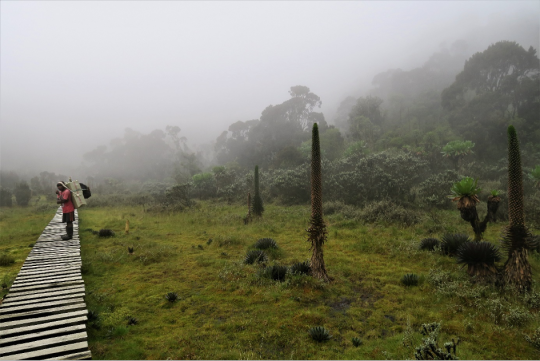
Crossing a wooden passage through one of the numerous bogs (Photo © Mike Styllas)
The high levels of humidity, as these tropical forests “respire” and the daily rain, were a good reminder that glaciers in the tropics are still surviving due to ever-recycled moisture and dense cloud cover. Other climate extremes over eastern Africa such as severe droughts were evident from the burned stacks of trees left behind from a wildfire that occurred nearly a decade ago. With so much rain and humidity during our stay, it was hard to imagine a wildfire burning the entire catchment, but in 2012 a widespread drought in the area, with two consecutive dry seasons and minimal rain during the intervening wet season occurred. The wildfire burned down significant portion of the upper catchment and climbed up to the proglacial area. The year after the wildfire, the devastative flash flood occurred when torrential rains over the burned slopes and released large amounts of water, mud, sediment from the upper catchment.
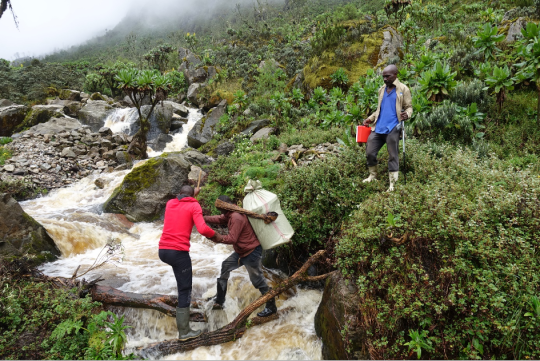
From the base of the mountain to our highest camp, we had to hike in rubber boots, as mud and continuous stream crossings filled our daily hiking menu (Photo © Martina Schoen)
In addition to the abundant moisture and water flowing everywhere, we were also struck by the dark color of the stream water. The entire setting appeared to be a great storage of carbon that was flushed out of these steep and densely vegetated catchments through the hydrographic network.

The typical landscape of the misty Rwenzori’s during the first days of our approach to the glaciers with the dark carbon rich water flowing everywhere. (Photo © Matteo Tolosano)
As we moved higher, successive glacial lakes and frontal moraines marked our entrance to the extensive proglacial zone, which unlike the mid and high-latitude glacial settings, was dressed in a tropical suit. As the glaciers extended down to these locations a few thousand years ago, it was amazing to see how fast vegetation can be established and climb to higher elevations in the tropical alpine belt. Cloud cover, moisture and rain kept being our companions on a daily basis.

Despite the dense vegetation the proglacial lake bounded by a terminal moraine, reminded us that the glaciers extended at this location a few thousand years ago (Photo © Martina Schoen)
When we finally reached Margherita camp and prepared our sampling equipment the cloud finally broke and we were suddenly exposed to a stunning alpine setting with small glaciers hiding between steep rock walls and rocky towers. Sampling the stream of Stanley glacier on a sunny day made all the muddy hiking and wetness related fatigue to evaporate and still looms like the perfect moment of our trip. However, even this day did not start as easy and the going in the rocky ledges was tough, as frozen moisture and verglass were spread over the cliffs and couloirs leading to Stanley Plateau. Then the cloud dissapeared and the views became fantastic as alpine Africa and Stanley glacier were basking into the strong tropical sun. The sunny day and the blue skies during our fieldwork time up there were definitely a highlight of this trip, but there were brighter moments during our Uganda expedition.

The intimidating view of the upper mountain from Margherita camp (Photo © Matteo Tolosano)

En route to Stanley Plateau. Nothing could foretell that this foggy, cold, wet and slippery scramble would lead to a glorious day (Photo © Martina Schoen)
While in Kampala, we had the chance to share Vanishing Glaciers project concept and recent sceintifc findings with the students of the Seven Hills International School. We are particularly thankful to Ms Romina Kohler, the Swiss Honorary Consulate in Kampala and to Ms Alice Bourgoin, the Head of the School for organizing this event. The general interest and the acute questions of the students, was a good reminder that young generations are aware and interested into issues related to climate change impacts on glaciers and alpine ecosystems. To our surprise, this event concluded with an aura of hope, as the millennials attending the talk were also seeking solutions to the ongoing climate and environmental crises.

Tom Battin, presenting the expeditions and most recent scientific findings of Vanishing Glaciers project to the students of the Seven Hill high school in Kampala. (Photo © Matteo Tolosano)
Over the two weeks spent on the slopes of Rwenzori Mountains, we had a great chance to become friends with our team of guides and porters. Besides the scientific part, the whole raid was a very informative process, as from the start of the trek we became exposed to several legends and myths that envelope the Rwenzori’s in a similar fashion as their moisture clouds. The mountain tribes were an open encyclopedia in terms of the plants healing and medical capabilities and our guides conveyed this collective empirical knowledge in every corner of the trail. Several talks with the team members over smoky fires burning wet wood invovled broader subjects like the social structure of Uganda, the civil war and the difficult years that followed, and gave us the chance to become familiar with the evolution of life in eastern Africa since the colonial times.

The team with Dr Rosemary Kawaga on its way to Uganda’s Vanishing glaciers (Photo © Martina Schoen)
The bonding with the entire team of porters and guides became stronger as the days went by. We were inspired by their professionalism and patience to make our expedition happen and by their willingness to share with us knowledge about their mountains and life experiences. On the downside, it was very disappointing to see that these bright people, among several difficulties of their everyday life, had to face the cold and humid conditions of the mountain with inadequate, not to say primitive equipment. The fact that we were hiking with a team of porters and guides lacking the essentials to pull out a trek like ours, ranged in our ears from day one. As the days went by and the conditions became harder, we felt that the least we could do upon return to Lausanne, was to organize a campaign and ship used outdoor equipment to these people that will make their work on the mountain as guides and porters a little easier.
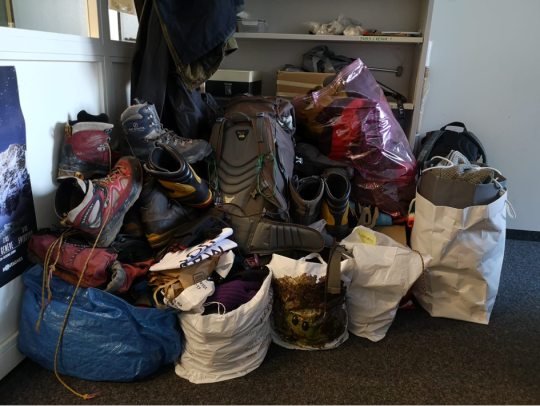
Mountain gear bound to Africa. Tom Battin’s initiative to collect used equipment and send it to Uganda found a great response from the UNIL – EPFL community (Photo © Matteo Tolosano)
In the end, the High Prize for our African expedition was not the demanding and successful sampling campaign of Africa’s vanishing glaciers. The highlight from our Rwenzori expedition is the fact that we did meet many hard working, bright people inhabiting the jewel of Africa and thanks to the solidarity response of the joint EPFL- UNIL community, these people with their big smiles, can work under better conditions on their beloved mountain and shine a little more. They deserve it!
Best Wishes for a Fruitful and Productive New year to the entire EPFL - UNIL community!
The Vanishing Glaciers project team
0 notes
Text
Exploring the last bits of the African tropical glaciers
Out of the wintery Lausanne, armed with vivid memories of High Mountain Asia, bound for the tropics this time to encounter the last African glaciers. When it comes to the impacts of climate change on the melting of the world’s glaciers, tropical glaciers are definitely the first victims. In Ecuador, we witnessed the tremendous retreat of the glaciers on the prominent volcanoes of the tropical Andes. This time we are privileged and challenged to conduct our fieldwork in the Vanishing Glaciers that tower the Pearl of Africa.
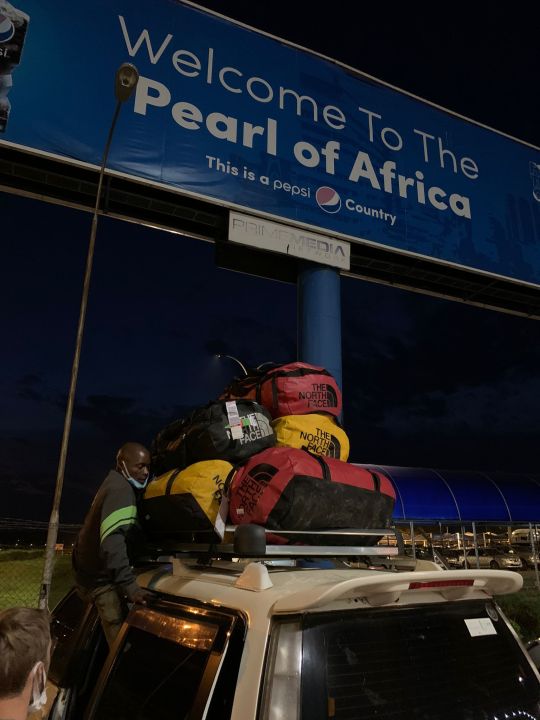
The glaciers of Uganda’s Rwenzori Mountains have witnessed a dramatic retreat that was nicely captured (https://www.youtube.com/watch?v=eHiRQMHtYFI) by Tim Jarvis’ project 25Zero. To the mountaineering world the adjacent Roof of Africa the Kilimanjaro, which also hosts last bits of African glacial ice, shadows the misty Rwenzori Mountains. However, the glaciers of the Rwenzori resemble better locations for Vanishing Glaciers project. An ice-capped peak protruding above the misty tropical forests can only have surprises, in its vegetation, in its scenery, in its microbial life, and in the adventure to reach the glacier.

As we start to see the light of logistical labyrinth in Uganda’s capital Kampala, we get increasingly impatient to be confronted to the misty mysteries of the Rwenzori Mountains.
The Vanishing Glaciers project team
Tom, Martina, Tyler, Matteo, Vincent & Mike
1 note
·
View note